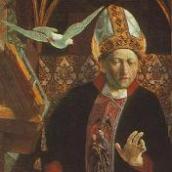|
|
Gregory Nazianzen
from the Fifth Theological Oration
(Portions of Oration XXXII in Vol VII, NPNF (2st))
XXXI. I have very carefully considered this matter in my own
mind, and have looked at it in every point of view, in order to find some
illustration of this most important subject, but I have been unable to
discover any thing on earth with which to compare the nature of the Godhead.
For even if I did happen upon some tiny likeness it escaped me for the
most part, and left me down below with my example. I picture to myself
an eye,59 a fountain, a river, as others
have done before, to see if the first might be analogous to the Father,
the second to the Son, and the third to the Holy Ghost. For in these there
is no distinction in time, nor are they torn away from their connexion
with each other, though they seem to be parted by three personalities.
But I was afraid in the first place that I should present a flow in the
Godhead, incapable of standing still; and secondly that by this figure
a numerical unity would be introduced. For the eye and the spring and the
river are numerically one, though in different forms.
XXXII. Again I thought of the sun and a ray and light. But here again
there was a fear lest people should get an idea of composition in the Uncompounded
Nature, such as there is in the Sun and the things that are in the Sun.
And in the second place lest we should give Essence to the Father but deny
Personality to the Others, and make Them only Powers of God, existing in
Him and not Personal. For neither the ray nor the light is another sun,
but they are only effulgences from the Sun, and qualities of His essence.
And lest we should thus, as far as the illustration goes, attribute both
Being and Not-being to God, which is even more monstrous. I have also heard
that some one has suggested an illustration of the following kind. A ray
of the Sun flashing upon a wall and trembling with the movement of the
moisture which the beam has taken up in mid air, and then, being checked
by the hard body, has set up a strange quivering. For it quivers with many
rapid movements, and is not one rather than it is many, nor yet many rather
than one; because by the swiftness of its union and separating it escapes
before the eye can see it.
XXXIII. But it is not possible for me to make use of even this; because
it is very evident what gives the ray its motion; but there is nothing
prior to God which could set Him in motion; for He is Himself the Cause
of all things, and He has no prior Cause. And secondly because in this
case also there is a suggestion of such things as composition, diffusion,
and an unsettled and unstable nature ... none of which we can suppose in
the Godhead. In a word, there is nothing which presents a standing point
to my mind in these illustrations from which to consider the Object which
I am trying to represent to myself, unless one may indulgently accept one
point of the image while rejecting the rest. Finally, then, it seems best
to me to let the images and the shadows go, as being deceitful and very
far short of the truth; and clinging myself to the more reverent conception,
and resting upon few words, using the guidance of the Holy Ghost, keeping
to the end as my genuine comrade and companion the enlightenment which
I have received from Him, and passing through this world to persuade all
others also to the best of my power to worship Father, Son, and Holy Ghost,
the One Godhead and Power. To Him belongs all glory and honour and might
for ever and ever. Amen.
59 Elias Cretensis says that the Eye in this passage is
not to be understood of the member of the body so called, but as the Eye
or the centre of a spring, the point from which the water flows.
|
|
